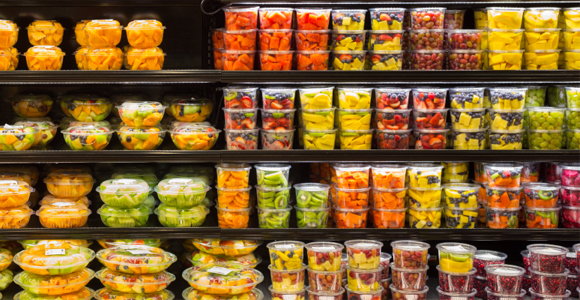Portion sizes in America have continued to increase. Despite the growing demands for more nutrient-rich and healthy choices, most people still want "more for less" and, unsurprisingly, there has not been much demand for reducing the amount of food one is served. The amount of food you are served in restaurants is often hugely disproportionate to what a single serving size is and can make it difficult for you to know how much you are consuming. Some restaurants serve single meals that are enough for two or more people! Additionally these meals often come with chips, bread and other meal additions.
Serving sizes are measured by standardized units of measurement such as cups and ounces, whereas a portion is the amount of a food you choose to eat at any one time and may be more or less than a serving. Serving sizes are found on nutrition labels, which help when you are eating packaged foods.
So when you are eating out or trying to keep better track of how much you are consuming, here are some ideas on how to visually assess what you are eating. It is important to realize that these are just for getting a general idea and not a highly accurate way of measuring food.
Your needs are specific for you. Fitday.com can help you determine what is right for your goals. But for an average 2000-calorie diet should be aiming to consume the following during a day:
- Grains: 6 ounce equivalents (or servings)
- Vegetables: 2 ½ cups
- Fruit: 2 cups
- Milk/ or Calcium-rich Foods: 3 cups
- Beans, Meat or Protein- Dense Foods: 5 ½ ounces
- A finger print: 1 teaspoon
- A thumb: 1-2 tablespoon or 1 ounce of food
- Tip of your thumb: 1 teaspoon
- Your fist: 1 cup or 8 ounces
- The palm of your hand: 3-4 ounces
- One cupped hand: ½ cup
- Two cupped hands: 1 cup or 1 ounce
- 1 Ping-Pong ball: 2 tablespoon
- 1 3-inch diameter baseball: 1 cup, 1 serving of pasta
- 1 Egg: ¼ cup
- 1 dice: 1 teaspoon of margarine
- 3 dice: 1 ounce of cheese
- 1 golf ball: 1 ounce of portion of nuts or protein
- 1 tennis ball: ½ cup or 1 serving of fruit
- 1 postage stamp: 1 serving of oil
- 1 computer mouse: 3 ounces, ½ cup
- 1 iPhone: 1 ounce
- 1 deck of cards: 2-3 ounces or ½ cup
- 1 nine-volt battery: 1 tablespoon / 1 ounce
- 1 8-ounce carton: 1 cup
- 1 4-ounce carton: ¼ cup
- Use small cups, plates and bowls!
- Start with small helpings and eat slowly. Keep the rest of the food out of sight so that you will be able to pay more attention to feeling full.
- Drink lots of water throughout your meals and day.
- Single-serving pre-portioned foods can help but for those who want to cut down on packing waste, break larger food packages into reusable containers and even pre-portioned containers.
- Remove food from the package while you eat it and place it in a bowl. This will help you visually see and assess how many portions you have served yourself.
- Measure cooked foods after cooking.
- Fill your plate with mostly vegetables, fruit and whole grains! Your protein source does not need to have the largest portion of your plate.

Some people get lucky and are born with fit, toned bodies. Andy Peloquin is not one of those people... Fitness has come hard for him, and he's had to work for it. His trials have led him to becoming a martial artist, an NFPT-certified fitness trainer, and a man passionate about exercise, diet and healthy living. He loves to exercise -- he does so six days a week -- and loves to share his passion for fitness and health with others.



